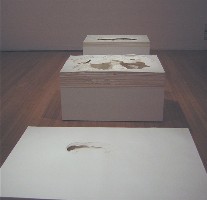 Roberta didn’t lie. She posted that I would write something about “Pulp:Paper Sculpture,” at Tyler’s Produce Gallery. The show, which has five artists from hot ticket Vik Muniz to local young artist Leslie Mutchler, explores how something basically flat and 2-dimensional can be sculptural. The show was curated by grad student/Produce Gallery advisor Omar Rodriguez-Graham, who was struck by the solidity of the material when he saw Japanese artist Noriko Ambe’s stratified paper landscapes three years ago in a show in Brooklyn.
Roberta didn’t lie. She posted that I would write something about “Pulp:Paper Sculpture,” at Tyler’s Produce Gallery. The show, which has five artists from hot ticket Vik Muniz to local young artist Leslie Mutchler, explores how something basically flat and 2-dimensional can be sculptural. The show was curated by grad student/Produce Gallery advisor Omar Rodriguez-Graham, who was struck by the solidity of the material when he saw Japanese artist Noriko Ambe’s stratified paper landscapes three years ago in a show in Brooklyn.
Ambe is also in the show and her three pieces are the jaw dropper. Her “Lands of Emptiness: Linear Actions Cutting Project” (right top) are stratified landscapes carved into paper. The cutouts create eroded-looking canyons and sink-holes, pristine and empty and voluptuous at the same time. These canyons or hollows, deliberately cut and removed, have a surprising grandeur and believability that is of course false. They are obsessive and controlled products of the imagination–somewhere and nowhere at once. By stacking the paper, the usually ignored third dimension of paper suddenly becomes a formal, striking presence. Ambe right now is working in New York (image top, “Lands of Emptiness: Linear Actions Cutting Project,” from front to back, 2Z, 2A and 2M.
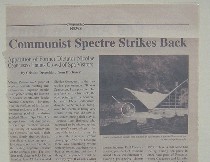 In contrast, Vik Muniz’ faux newspaper articles raise issues of what’s real and what’s not, but he’s not raising issues about the third dimension of paper. The articles are on yellowed newsprint with torn edges and look like they might be the real thing. But each of the articles parodies some cultural phenomenon–in Las Vegas, a Gerhy-designed art museum is nixed because Gerhy doesn’t get the neon aesthetic of the town; in Romania, tourists flee after sighting the ghost of former dictator Nicolae Ceaucescu; in outer space, an artist with an almost-real name (Ross Bleckman instead of Bleckner) rides the space shuttle courtesy of NASA to bridge art and science and and study creativity and visual cognition in space (left, Ceaucescu item in “Personal Articles” series).
In contrast, Vik Muniz’ faux newspaper articles raise issues of what’s real and what’s not, but he’s not raising issues about the third dimension of paper. The articles are on yellowed newsprint with torn edges and look like they might be the real thing. But each of the articles parodies some cultural phenomenon–in Las Vegas, a Gerhy-designed art museum is nixed because Gerhy doesn’t get the neon aesthetic of the town; in Romania, tourists flee after sighting the ghost of former dictator Nicolae Ceaucescu; in outer space, an artist with an almost-real name (Ross Bleckman instead of Bleckner) rides the space shuttle courtesy of NASA to bridge art and science and and study creativity and visual cognition in space (left, Ceaucescu item in “Personal Articles” series).
Muniz, by the way, will have a show this spring at the Pennsylvania Academy of the Fine Arts (see post).
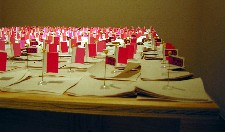 Leslie Mutchler’s “The Affected Model of a Flawed Paradigm in the H-O Scale” (detail right) turns newsprint into a landscape atop a plywood sheet–hence the model-trains reference in the title. This landscape, as the name suggests, is flawed. Instead of the looping train tracks and faux rolling hills, we’ve got a city grid, the streets between stacks of newsprint that are just about the same size as Post-it pads, each with a little pinky-red-orange street sign, some of them instructing us to “sign here.” The affect is computer-chip like, and repetitive, the piled papers like buildings, the world of office life reduced to reams, cubicles, tyrannical square piles for round humans.
Leslie Mutchler’s “The Affected Model of a Flawed Paradigm in the H-O Scale” (detail right) turns newsprint into a landscape atop a plywood sheet–hence the model-trains reference in the title. This landscape, as the name suggests, is flawed. Instead of the looping train tracks and faux rolling hills, we’ve got a city grid, the streets between stacks of newsprint that are just about the same size as Post-it pads, each with a little pinky-red-orange street sign, some of them instructing us to “sign here.” The affect is computer-chip like, and repetitive, the piled papers like buildings, the world of office life reduced to reams, cubicles, tyrannical square piles for round humans.
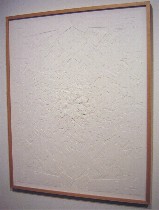 I would compare how John Powers uses paper, applying rectangles and squares of paper to create a rather architectural relief, to how Astrid Bowlby accretes modular paper shapes. But Powers is working small and contained in a rectangle with no marks. Bowlby pushes the the layers beyond the picture frame, her lyrically outlined and cut shapes becoming enormous installations that place you physically in a surging paper landscape–see post (image, Powers’ “Full Carpet”).
I would compare how John Powers uses paper, applying rectangles and squares of paper to create a rather architectural relief, to how Astrid Bowlby accretes modular paper shapes. But Powers is working small and contained in a rectangle with no marks. Bowlby pushes the the layers beyond the picture frame, her lyrically outlined and cut shapes becoming enormous installations that place you physically in a surging paper landscape–see post (image, Powers’ “Full Carpet”).
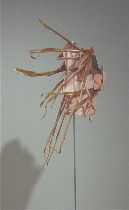 Ryan Johnson, also a New York artist, offers a paper sculpture that focuses on the flat, 2-D side formed to make non-flat planes and taking advantage of the lightness of paper, it’s ability to not sink. “Redhead,” with airborne hair (right), is a head on a stick, and it made me think about how red hair holds your attention before the body beneath registers on your consciousness. In a way, this is the most traditional of the pieces, the least conceptual. It’s a traditional portrait sculpture, just made of paper.
Ryan Johnson, also a New York artist, offers a paper sculpture that focuses on the flat, 2-D side formed to make non-flat planes and taking advantage of the lightness of paper, it’s ability to not sink. “Redhead,” with airborne hair (right), is a head on a stick, and it made me think about how red hair holds your attention before the body beneath registers on your consciousness. In a way, this is the most traditional of the pieces, the least conceptual. It’s a traditional portrait sculpture, just made of paper.
I might not have visited the show if I weren’t already attracted to the Northeast suburbs by a show first curated for a New York gallery and then brought in by Abington Art Center’s new curator, Amy Lipton. You know, drive out to Abington,you might as well drive over to Cheltenham. Also both were open on a Tuesday, a big plus in an art world that has decided Monday and Tuesday are the weekend. The thing that sealed it was running into Rodriguez at the screening of “Atanarjuat” Saturday–see post.
I also got lost (help, I need my urban grid; I’m more at home in Mutchler’s H-O scale organization than the idealized suburban and country landscapes of model-train enthusiasts). I finally followed the setting sun, and much to my surprise, came upon Cheltenham Avenue, which I’m still trying to figure that out.
Anyway, seeing the show at Abington and this one in the same trip was a good way to go.









